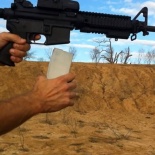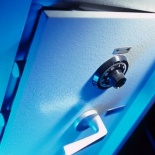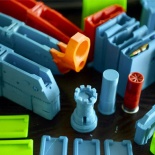Not sizable for large scale production
Despite being a reliable manufacturing technique, 3D printing is only technically and economically feasible for high value, low volume parts (3D printing is cheap in comparison to the value of the parts produced), with increased diminishing returns for every additional production piece made. If production runs of over a ten thousand pieces a year, mass manufacturing techniques such as die casting (for metals), injection moulding (plastics and metals) will triumph over 3D printing in overall cost effectiveness given evident of economies of scale, despite the relatively higher initial capital outlay.
Threats to national security
The rapid adaptation of 3D printing to the masses opens several avenues of firearms exploitations and related equipment of destruction. The dangers or 3D printed guns are not new, but very real, this allows users to reproduced government controlled parts to produce a working firearm or spawning a new breed of easily concealable firearms completely undetectable by airport checkpoint or scanners.
These guns can even be disguised or made to look like everyday items and fired using ammunition with propellants made by conventional household chemicals. 3D printed IEDs (improvised explosive devices) can be disguised to look like normal everyday street objects and dangerously planted in crowded areas without detection. Also, the increased success rate of bio-printers may also potentially be exploited to print energetic chemical formulations such as ricin, anthrax or methamphetamine. Though most authorities today are aware of such 3D printed dangers, few law enforcement agencies around the world have yet to implement appropriate laws to guard against such ease of accessibility new threats.
Intellectual property protection challenges
The ease of obtaining, modifying and distributing 3D printed files often results in Intellectual property protection issues and loss of secrets traditionally unobtainable unless a physical part is obtained. Handheld 3D scanners are widely used in the automotive and forensics allowing any given scene or solid body in 3D space to be scanned, mapped and digitally saved.
It can be the contours of a new automotive clay model or a recreation of a whole traffic accident scene for crime investigations. When complimented with 3D printers, this allows anybody to simply scan-copy a physical product, reverse engineer and print the copied part instantly. This will be of particular concern and important to organisations dealing with company secrets or classified vulnerable to espionage and thief of military designs in public areas.
Problems of part accountability
To date, most countries are unable to settle justifications product liability with regards to 3D printed parts, given the blurring of direct and indirect parties leading to the lack of clear stakeholder accountability. Given the potential real threats of 3D printing, if a user for example were to use a 3D printed part sourced from the internet to do injustice, will the original part designer, website owner, Internet service provider (who delivered the file to the user), 3D printer manufacturer or the user be ultimately responsible for the chain of actions? This issue is still not clearly understood and unaccounted for by authorities even in most developed nations to date.
Lack of common quality standards for 3D printed parts.
There are many variables which can drastically affect final part performance and quality of 3D printed parts. The final quality is often largely determined by the chosen material itself, production conditions, machine properties and operator proficiency.
This would be of grave concern as increasing number of critical parts are currently manufactured using 3D printing. Boeing uses nearly 20 thousand different parts on 10 different aircraft including the 787 Dreamliner and F-35 (900 parts). Such quality control are normally done by companies in-house, presenting cross-compatibility issues with varying standards of acceptance of 3D printed parts across countries, particular in today’s global supply chain. Though this could be partially attributed by little reliability data of such parts in-service, the need for an international standard government 3D printer parts is essential for international conformance, minimising potential part failure and increasing known reliability of 3D printed parts.
In conclusion
In all, The future does look bright for 3D printing and is here to stay, despite the evident challenges and possible pitfalls which can be properly addressed by appropriate laws and guidelines in place. Only time will tell, it will be a matter of time where 3D printers will find their way into household as an appliance as common as the computer, making the dream of localised fabrication more of a thing of reality.
(You are currently viewing page 3/3)
- Page 1/3 » Technology background and how it works
- Page 2/3 » Advantages, Benefits of additive 3D printing
- Page 3/3 » Disadvantages of 3D printing




I feel you are spot-on and agree that good quality undoubtedly matters!